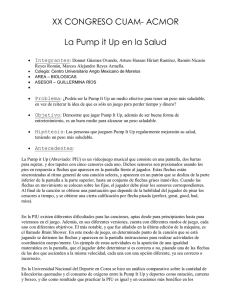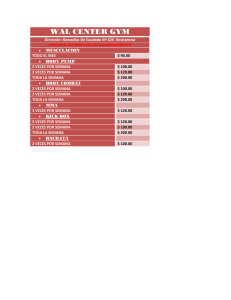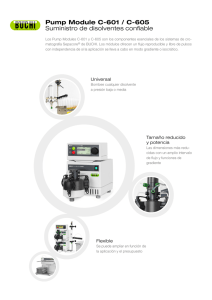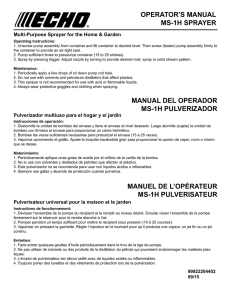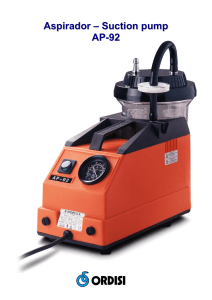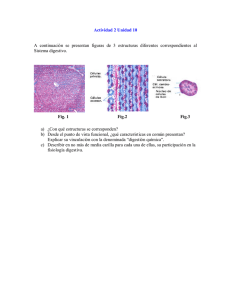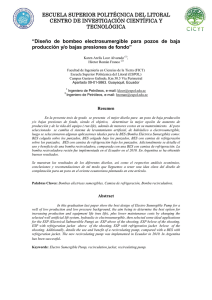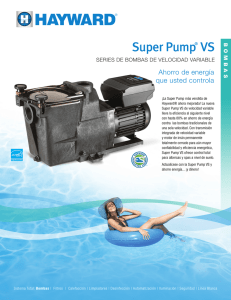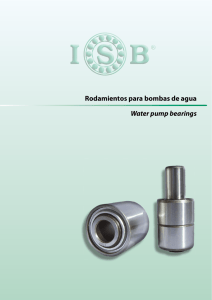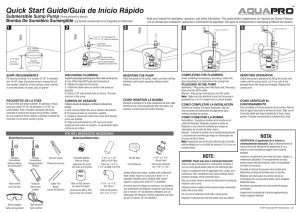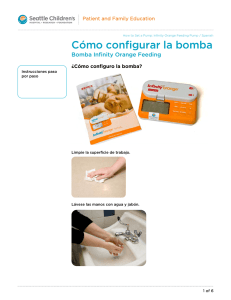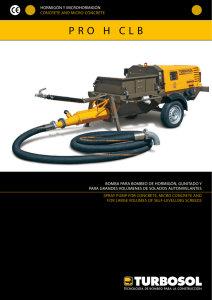P1. - Water at 20°C is to be pumped through 2000 ft of pipe from
Anuncio
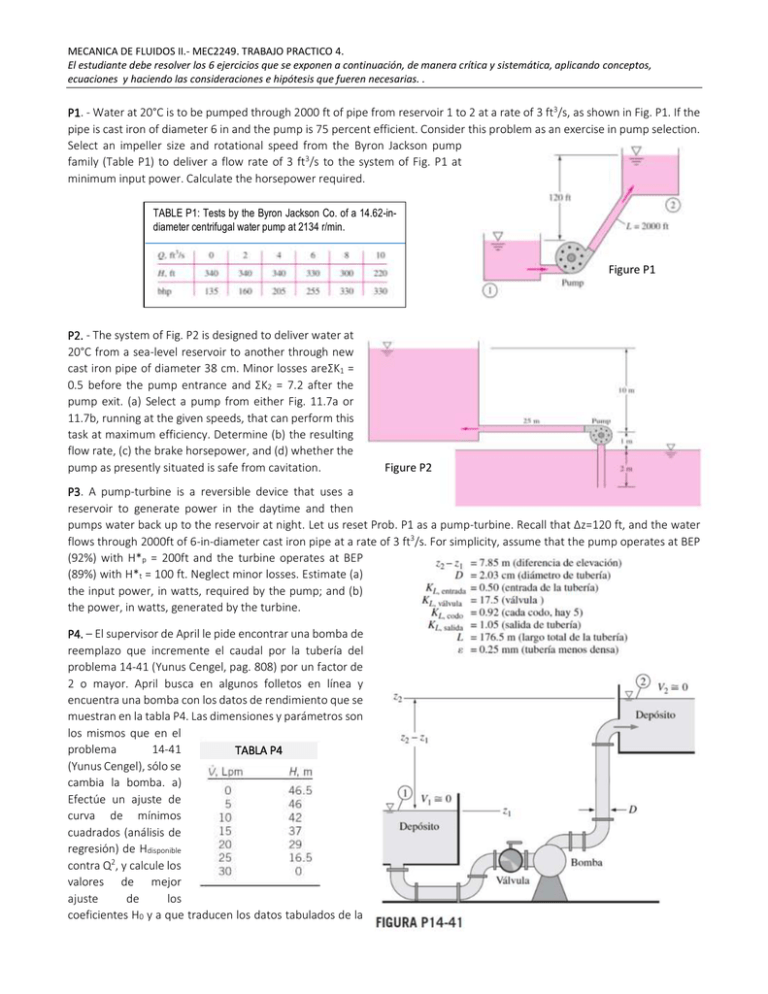
MECANICA DE FLUIDOS II.- MEC2249. TRABAJO PRACTICO 4. El estudiante debe resolver los 6 ejercicios que se exponen a continuación, de manera crítica y sistemática, aplicando conceptos, ecuaciones y haciendo las consideraciones e hipótesis que fueren necesarias. . P1. - Water at 20°C is to be pumped through 2000 ft of pipe from reservoir 1 to 2 at a rate of 3 ft3/s, as shown in Fig. P1. If the pipe is cast iron of diameter 6 in and the pump is 75 percent efficient. Consider this problem as an exercise in pump selection. Select an impeller size and rotational speed from the Byron Jackson pump family (Table P1) to deliver a flow rate of 3 ft3/s to the system of Fig. P1 at minimum input power. Calculate the horsepower required. TABLE P1: Tests by the Byron Jackson Co. of a 14.62-indiameter centrifugal water pump at 2134 r/min. Figure P1 P2. - The system of Fig. P2 is designed to deliver water at 20°C from a sea-level reservoir to another through new cast iron pipe of diameter 38 cm. Minor losses areΣK1 = 0.5 before the pump entrance and ΣK2 = 7.2 after the pump exit. (a) Select a pump from either Fig. 11.7a or 11.7b, running at the given speeds, that can perform this task at maximum efficiency. Determine (b) the resulting flow rate, (c) the brake horsepower, and (d) whether the pump as presently situated is safe from cavitation. Figure P2 P3. A pump-turbine is a reversible device that uses a reservoir to generate power in the daytime and then pumps water back up to the reservoir at night. Let us reset Prob. P1 as a pump-turbine. Recall that Δz=120 ft, and the water flows through 2000ft of 6-in-diameter cast iron pipe at a rate of 3 ft3/s. For simplicity, assume that the pump operates at BEP (92%) with H*p = 200ft and the turbine operates at BEP (89%) with H*t = 100 ft. Neglect minor losses. Estimate (a) the input power, in watts, required by the pump; and (b) the power, in watts, generated by the turbine. P4. – El supervisor de April le pide encontrar una bomba de reemplazo que incremente el caudal por la tubería del problema 14-41 (Yunus Cengel, pag. 808) por un factor de 2 o mayor. April busca en algunos folletos en línea y encuentra una bomba con los datos de rendimiento que se muestran en la tabla P4. Las dimensiones y parámetros son los mismos que en el problema 14-41 TABLA P4 (Yunus Cengel), sólo se cambia la bomba. a) Efectúe un ajuste de curva de mínimos cuadrados (análisis de regresión) de Hdisponible contra Q2, y calcule los valores de mejor ajuste de los coeficientes H0 y a que traducen los datos tabulados de la MECANICA DE FLUIDOS II.- MEC2249. TRABAJO PRACTICO 4. El estudiante debe resolver los 6 ejercicios que se exponen a continuación, de manera crítica y sistemática, aplicando conceptos, ecuaciones y haciendo las consideraciones e hipótesis que fueren necesarias. . tabla P4 en la expresión parabólica Hdisponible = H0 - aQ2. Grafique los datos como los valores numéricos y el ajuste de curva como una línea para comparación. b) Use la expresión obtenida en el inciso a) para estimar el caudal de operación de la nueva bomba si se reemplazara la bomba existente con todo lo demás igual. ¿Logró su objetivo April? c) Construya una gráfica de la carga hidrostática neta requerida y la carga hidrostática neta disponible como funciones de caudal e indique el punto de operación sobre la gráfica. P5.- An interesting turbomachine is the fluid coupling of Fig. P5, which circulates fluid from a primary pump rotor and thus turns a secondary turbine on a separate shaft. Both rotors have radial blades. Couplings are common in all types of vehicle and machine transmissions and drives. The slip of the coupling is defined as the dimensionless difference between shaft rotation rates, s = 1 - ωs/ωp. For a given volume of fluid, the torque T transmitted is a function of s, ρ, ωp, and impeller diameter D. (a) Nondimensionalize this function into two pi groups, with one pi proportional to T. Tests on a 1-ft-diameter coupling at 2500 r/min, filled with hydraulic fluid of density 56 lbm/ft3, yield the following torque versus slip data: (b) If this coupling is run at 3600 r/min, at what slip value will it transmit a torque of 900 ft-lbf? (c) What is the proper diameter for a geometrically similar coupling to run at 3000 r/min and 5 percent slip and transmit 600 ft-lbf of torque? Figure P5 MECANICA DE FLUIDOS II.- MEC2249. TRABAJO PRACTICO 4. El estudiante debe resolver los 6 ejercicios que se exponen a continuación, de manera crítica y sistemática, aplicando conceptos, ecuaciones y haciendo las consideraciones e hipótesis que fueren necesarias. . ANEXO
